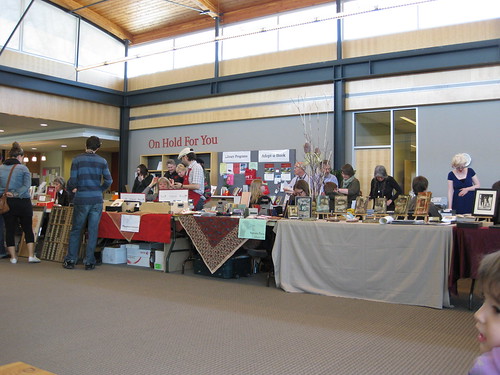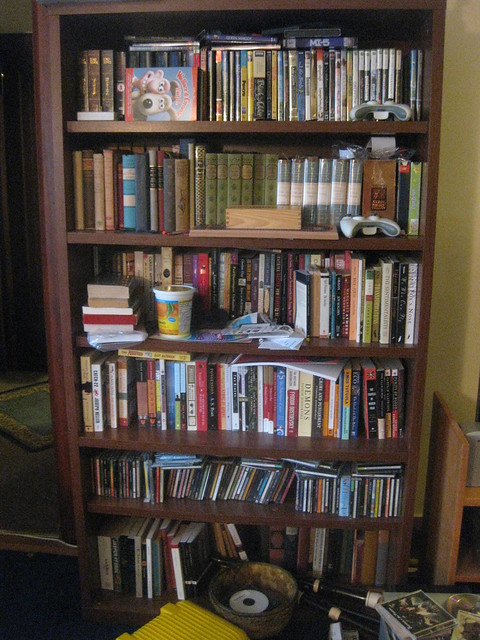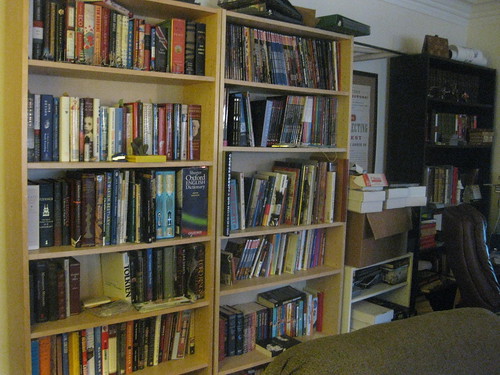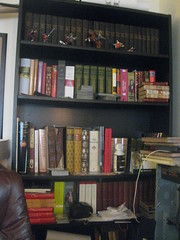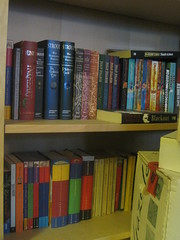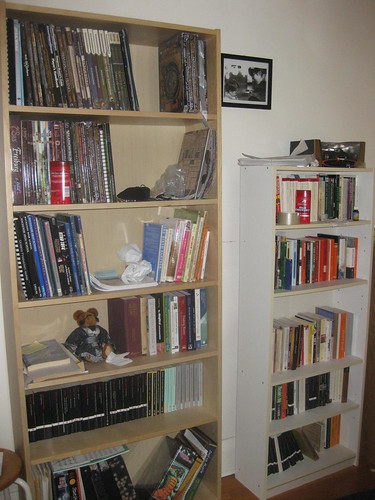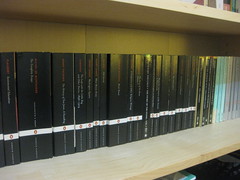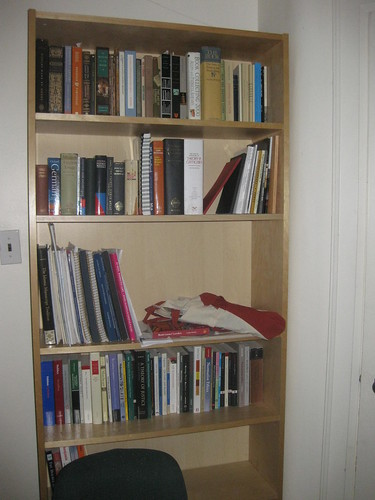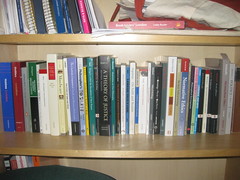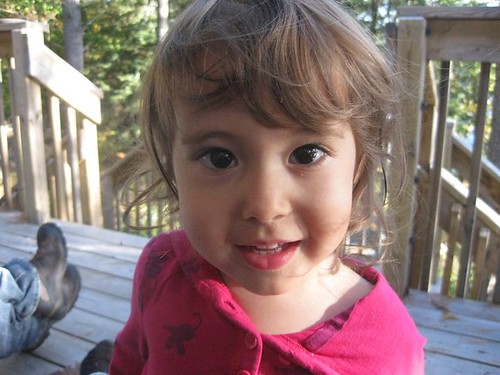November 21, 2011
Back to Work!

Oonagh Elizabeth, her grandmother, and a carrot.
It has been five months since my last post. It has been an eventful five months for me. I am now mother to two beautiful girls, the younger of whom turned four months old yesterday. This might seem like a short “maternity leave” by Ontario standards, but Oonagh is a shockingly calm and self-satisfied baby and now, just over the newborn hump, I find I have no further excuse to avoid writing from time to time.
Not that I am looking for an excuse – I have been mentally composing blog posts for months now as exciting and interesting bookish things have cropped up, but have simply lacked the spare hands to type them up. I’ve re-read two epic speculative fiction series with mixed feelings, had heaps of much-anticipated new releases arrive for me at my bookstore, watched a really exciting awards season come and go, met new friends who also happen to be writers, discovered a true love of Canadian children’s storyteller Celia Barker Lottridge, had revelations about a three-year-old’s expectations of narrative, learned bizarre new things about digital textbooks… all of which I’m drooling to blog about, and will, over the next few months.
 But probably most pressing, as my readers probably already know, is the imminent announcement of this year’s Canada Reads picks! I haven’t been following the bloggosphere at all these past months so I post this in innocence of everyone else’s three cents worth. But for my part, I am excited this year. While the CBC hasn’t abandoned their new crowd-sourcing mechanism for picking books (which I railed about last year) this year’s focus on non-fiction pretty much scuttles any potential that the final list will wind up as lackluster as last year’s. Canadian non-fiction is virgin territory for Canada Reads, and every one of the top 10 books (and, really, the top 40) is a big, relevant, important read. They can’t really go wrong, unless the five panelists are all 17-year-old reality television refugees without a literary credit among them. My reading this year – especially over the last six months – has been shamefully indulgent, so I’m thrilled to have an impending pile of books which will actually challenge my sleep-deprived and rusty intellect a little. My great hope is that the same will be true of the scores of people who read these books this year.
But probably most pressing, as my readers probably already know, is the imminent announcement of this year’s Canada Reads picks! I haven’t been following the bloggosphere at all these past months so I post this in innocence of everyone else’s three cents worth. But for my part, I am excited this year. While the CBC hasn’t abandoned their new crowd-sourcing mechanism for picking books (which I railed about last year) this year’s focus on non-fiction pretty much scuttles any potential that the final list will wind up as lackluster as last year’s. Canadian non-fiction is virgin territory for Canada Reads, and every one of the top 10 books (and, really, the top 40) is a big, relevant, important read. They can’t really go wrong, unless the five panelists are all 17-year-old reality television refugees without a literary credit among them. My reading this year – especially over the last six months – has been shamefully indulgent, so I’m thrilled to have an impending pile of books which will actually challenge my sleep-deprived and rusty intellect a little. My great hope is that the same will be true of the scores of people who read these books this year.
The big reveal is Wednesday, and I promise to do my homework between now and then. I’ll be back on twitter, the blogs, and, come Wednesday, the CBC building! Anyone else going to be there? I could use a little hand-holding through my return to the adult world. Not to mention that it will be the first time in months I’ll have two-or-more hours spent without a pre-schooler attached to me. I want to make the most of it!
No pressure, I’m sure I’ll enjoy myself either way! See you around…
June 1, 2011
Treasures from Far Away
I received a very generous package in the mail a couple of months ago, a gift I’d have blogged about sooner but for the fact that I hadn’t, at that time, any real information about what I’d been given. It was a box of books, all by Alexandre Dumas, and all published in Hebrew.
The sender, a collector of Hebrew children’s books who lives in Israel, had included little notes telling me the literal translations of the titles, but little else. I suppose not much else was needed, but the book historian in me wanted to know more: were the books printed in Israel? Was the art local as well? Are these abridged or complete editions? What kind of things might be added, or subtracted? What makes these books distinctive or representative of where they came from?
So they sat on the shelf at my book store waiting for a Rabbi acquaintance of mine to visit so that I might pick his brain. He did, finally, arrive, but I’m sorry to say he couldn’t give me much more information than I already had. The books didn’t have much more direct information printed on them, and my research is hamstrung by a linguistic barrier. My kingdom to be a polyglot, let me tell you what. But this is an old story in book history circles – we all only read so many languages (in my case, a whopping two) and so the study of literature tends to be pretty localized. Never mind. The books are still beautiful.
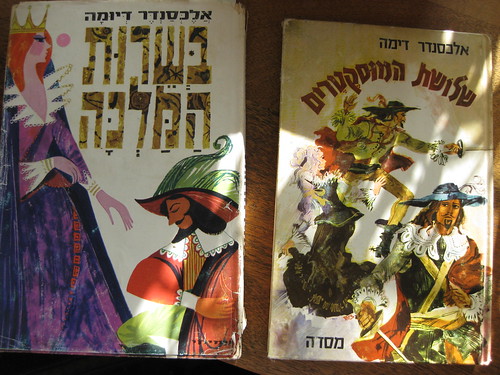 The books in the photo on the left are Hebrew editions of The Three Musketeers (right) and something called “Au service de la reine” (left). The latter is not a title used by Dumas for any of his works, and so could be anything from a selection of short stories, to excerpts from one of the romances, perhaps the Musketeers or The Queen’s Necklace. Both are large print editions, and Au service also shows use of vowels, something not typically included in a grown-up book for native readers of Hebrew. The name of the author has been translated differently on one book than the other. To the best of my knowledge, the cover art is specific to this edition.
The books in the photo on the left are Hebrew editions of The Three Musketeers (right) and something called “Au service de la reine” (left). The latter is not a title used by Dumas for any of his works, and so could be anything from a selection of short stories, to excerpts from one of the romances, perhaps the Musketeers or The Queen’s Necklace. Both are large print editions, and Au service also shows use of vowels, something not typically included in a grown-up book for native readers of Hebrew. The name of the author has been translated differently on one book than the other. To the best of my knowledge, the cover art is specific to this edition.
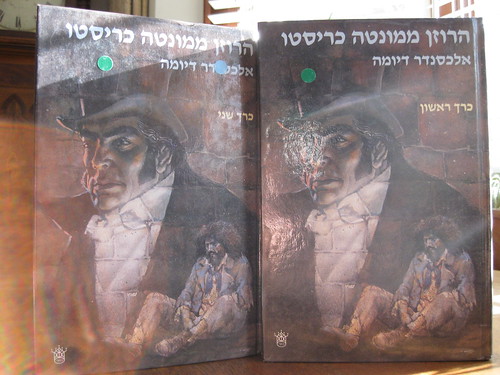 Next, we have a 2-volume edition of The Count of Monte Cristo which looks decidedly more serious. Editions of Monte Cristo tend to, no matter where they are from. I suppose this is because this is one of literature’s most famous stories of uncompromising revenge. Not quite all fun and games for kids, though I hasten to add that The Three Musketeers has its share of tears as well – recall that D’Artagnan’s lover Constance Bonacieux is done away with pretty handily, as is Milady. I have a sombre Spanish edition of Monte Cristo (“El Conde de Montecristo“) that I once felt reflected something of the Spanish character, but I now suspect is more in keeping with most publishers’ interpretation of the story.
Next, we have a 2-volume edition of The Count of Monte Cristo which looks decidedly more serious. Editions of Monte Cristo tend to, no matter where they are from. I suppose this is because this is one of literature’s most famous stories of uncompromising revenge. Not quite all fun and games for kids, though I hasten to add that The Three Musketeers has its share of tears as well – recall that D’Artagnan’s lover Constance Bonacieux is done away with pretty handily, as is Milady. I have a sombre Spanish edition of Monte Cristo (“El Conde de Montecristo“) that I once felt reflected something of the Spanish character, but I now suspect is more in keeping with most publishers’ interpretation of the story.
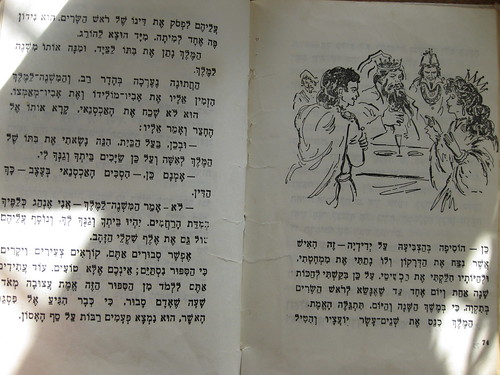 If you have any idea what this one could be, do share. The title is, literally translated, The Twin Hunters; again not a title Dumas uses for anything. It is a collection of children’s stories about animals. The pictures are often very clearly influenced by 20th century renditions of well-known fairy tales, but are also examples of very early Israeli engraving and printing (circa 1960s). Based on the pictures I found myself doubting if these were Dumas at all, but the work is most certainly attributed to him. Well, who knows? This is the fellow, after all, who penned the version of The Nutcracker that we all know from the Tchaikovsky ballet. If he’d hacked up a version of Sleeping Beauty or similar as well, I wouldn’t be surprised.
If you have any idea what this one could be, do share. The title is, literally translated, The Twin Hunters; again not a title Dumas uses for anything. It is a collection of children’s stories about animals. The pictures are often very clearly influenced by 20th century renditions of well-known fairy tales, but are also examples of very early Israeli engraving and printing (circa 1960s). Based on the pictures I found myself doubting if these were Dumas at all, but the work is most certainly attributed to him. Well, who knows? This is the fellow, after all, who penned the version of The Nutcracker that we all know from the Tchaikovsky ballet. If he’d hacked up a version of Sleeping Beauty or similar as well, I wouldn’t be surprised.
Part of me loves that I have no idea what these books are. It’s all part of the ongoing mystery. I am a wretched book collector in that sense – I don’t have a neat and tidy checklist of specific editions that I intend to buy, I prefer lobs from left-of-field. Put together now, for example, I have 18 copies of The Three Musketeers in five different languages. Nothing would please me more than a whole array of foreign editions, each less scrutable than the last. I do love the universality of Papa Dumas, and the endless diversity of books humanity has produced!
May 3, 2011
My Weekend in Grimsby
Can I just say, Grimsby is a beautiful little town! I’m jealous of anyplace that gets a proper green, flowered spring, and such a spring was certainly on display Saturday when we visited for the the 33rd Annual Wayzgoose. The atmosphere was warm, cheerful and tastefully tactile.
As a bonus, the Grimsby Public Art Gallery was also displaying The Nature of Words, a travelling exhibit of book-related art. I saw this show when it debuted in Toronto and wasn’t completely captivated by it. The artists represented were top-notch book artists in their various fields (binders, printers, paper makers and so on) but the focus of the exhibit was on words rather than the means of transmitting those words. The result was a lot of out-of-context prints, banners and fragments which failed (in my opinion) to show the best of what these accomplished book makers could do.
However, in Grimsby the artists and presses who participated in The Nature of Words had their booths in the gallery, and finally visitors could see the really stunning work in book form that they produce. These were among my favourite offerings of the show – Will Rueter’s Aliquando Press had nearly their entire catalogue on hand and I was totally taken by the lovely work Locks’ Press had on offer. Binder Don Taylor’s booth had some design bindings on hand as well as smaller pamphlets from his Pointyhead Press. If The Nature of Words had originally contained more of these press’s books and less “art”, I might have enjoyed it more the first time around!
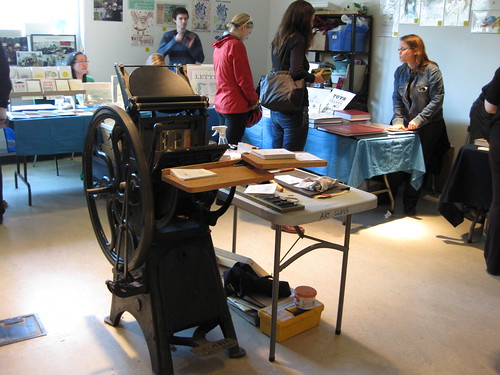 But not everybody – not even book arts followers – are as fixated on books themselves as I am, and the rest of the show featured as many if not more presses and artists who work outside of the codex form. There was a glut of cards, bookmarks, prints and posters, coasters and other paper-based curios. This makes for incredible shopping, regardless of your interest! It’s far too easy to spend $2-$10 at every single booth in the show buying some beautifully printed bit of ephemera or another. Which I did, I think. How could I not? My favourite ephemeral offering? Grocery lists from the Mackenzie Heritage Printery & Newspaper Museum:
But not everybody – not even book arts followers – are as fixated on books themselves as I am, and the rest of the show featured as many if not more presses and artists who work outside of the codex form. There was a glut of cards, bookmarks, prints and posters, coasters and other paper-based curios. This makes for incredible shopping, regardless of your interest! It’s far too easy to spend $2-$10 at every single booth in the show buying some beautifully printed bit of ephemera or another. Which I did, I think. How could I not? My favourite ephemeral offering? Grocery lists from the Mackenzie Heritage Printery & Newspaper Museum:
I wish I could say I restricted my buying to tiny and affordable curios, but I did not. I couldn’t leave without this year’s Wayzgoose Anthology. These books contain one signature (a folded sheet) from each of the exhibitors. The final product is a strange mish-mash of beautifully printed poems and essays, lithographs and woodcuts, fold-out maps, hand-coloured drawings, collages and handbills. I would estimate that 100-130 of these were printed and bound, the majority of which go to the exhibitors. I NEEDED TO HAVE ONE.


Some of my Wayzgoose pages...
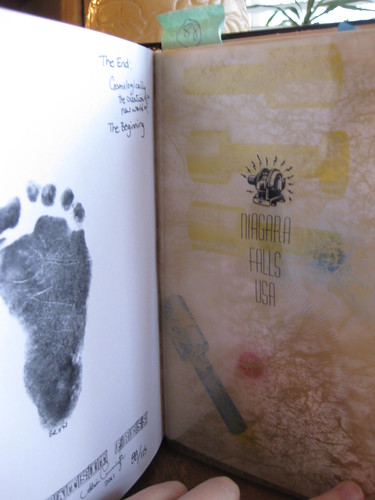
More Anthology pages...
February 25, 2011
Wild Books I Have Known
Steph at Bella’s Bookshelves recently published a lovely post about “37 books that I’ve known and loved enough to feel a sense of familiarity and affection when I see them on my shelves.” It got me to thinking about my own personal reading attachments, especially in light of the fact that for the last few weeks all I’ve been able to bring myself to read is Frank Herbert’s Dune chronicles, for probably the 10th time. A devoted reader is lucky when on that rare occasion a book grips her enough to really get lost in it, forming an attachment for life that’s hard to describe in terms of any other media, except perhaps film.
In my own experience, I have only really fallen in love with one or two books every couple of years. Even that, though, amounts to quite a number of books – so I thought I’d offer an even more specific list. I was thinking about what books formed me. Not “which books were my favorites” or “which books are the best”, but which books really and completely seized me and changed the way I thought, or changed the direction of my life. I look at them, and have to wonder: those people who don’t read – and there are a lot of them – what forms them? Because god knows who I would be without books. Nothing like me. And god knows who I would be without these specific works.
What about you? What are the books that built you?
The Lion, The Witch and The Wardrobe by C. S. Lewis
My mother read this book to me for the first time when I was six, and it terrified me. I don’t remember being terrified – I remember being a little bit alarmed by Fenris Ulf – but apparently I was alarmed enough that my mum stopped reading at this point and didn’t come back to it for the rest of the year.
But she did eventually read them all to me, and then I read them again myself, and again, and again, and again. I was so convinced that Narnia was a real place and that with enough determination I could get there that I absolutely obsessed night and day over it. I read the books in painstaking detail looking for clues about how to get there, or evidence that The Last Battle was in fact a forged work by the White Witch designed to fool us into thinking Narnia wasn’t there anymore so that we (read: clever and adventurous children like myself) would stop showing up. I had every bit of Narnia paraphernalia you could name, lions were my favorite animal, and I even tried to read Lewis’s sci-fi in the hopes that they contained more clues to the true fate and location of Narnia. They, for the record, did not.
I don’t remember giving up on Narnia until I was into grade six – and even then it was only because I moved to Calgary and my co-Narniite (Livia, my then-best friend) moved to London. I would have been 10 by then – so Narnia seized me for about four solid years.
Dune by Frank Herbert
I read Dune the summer between grade eight and nine – all the rest of the series too. This was a mind-blowing experience. Call it egoism, but I seemed to have decided that becoming an omniscient, timeless, infinitely-wise super-being was something immediately within my grasp. Not only that, I was sure that the route to Wisdom was in A) all the adult reading I could cram into my head B) transient, mind-altering ingestibles (i.e. the Spice, or chocolate covered coffee beans) and C) totally obsessive introspection and/or navel gazing. I also spent a good deal of that summer teaching myself tricks of self-control, like moving only one muscle with the exclusion of all others or inducing sleep at any time or place (in myself, of course. I was big on breathing excersizes.)
I also fell in love with Duncan Idaho and another boy on my soccer team whose name was (coincidence? I don’t think so.) also Duncan.
Mostly, I read anything which I could pretend had “value” (i.e. no more pulp!) and thought about it until my head hurt.
Cat’s Cradle by Kurt Vonnegut
It was Kurt Vonnegut that made me want to become a writer. Not that I had any intention of writing what he did – although I kept a journal trying to record amusing, cynical and anecdotal observations about the real world – but he gave me a different idea of what writing could be. It wasn’t just disembodied narrative, a story told by anyone to anyone. You could be a character, the teller, and pour yourself into the reader with great effect. He also taught me irony, deadpan and sarcasm – oh how I absorbed them. Thank god by the time I read Vonnegut I was beyond obsessing over the contents of a book – although I did recognize myself as a Bokononist for some time. He was the first I read where it was the form of the book, the writing – not the story – that impressed me.
Dreams Underfoot by Charles de Lint
This is one of Charles de Lint’s many books – and for whatever reason, the one that stabbed me in the heart. This book precipitated me leaving home. The year before I went through a very short Once and Future King phase – a book which I debated adding to this list but left off because I can’t quantify what it meant to me as well – in which I was going to be a filmmaker and my magnum opus was going to be a three-part O&F film. I still have a script I did up of the first half of The Sword and the Stone. For whatever reason I had become disillusioned with my film-making skills and was desperate for something more to my talents. In Dreams Underfoot I thought I found it.
I was going to be a gypsy, a transient, a busker and an artist as well as a part-time waitress. I couldn’t pick a favorite character in Newford (Jilly) so I wanted to be all of them. I really just suddenly identified very strongly with a lifestyle, a subculture, a people. I picked up violin again and taught myself to fiddle and worked out a comprehensive plan for hitting the road in a permanent sense. It changed my fashion sense, my outlook and my expectations. Finding these people made my heart soar. The only real letdown was when I finally got to Toronto and didn’t find a single like mind.
Good News for a Change by David Suzuki & Holly Dressel
This was a David Suzuki book I bought on a whim because I was newly into “collecting” books and, at Nicholas Basbane’s suggestion, felt my “collection” needed a theme. I was watching a lot of The Nature of Things at the time and for whatever reason decided I wanted a science/nature/environment themed collection. This was in hardcover, and the last copy available at Book City, so I bought it.
At the time I had re-enrolled at the University of Toronto (after a previous stint studying Celtic Studies under the aforementioned influence of DeLint) and was planning on doing a degree in French Literature to pursue my love of Dumas (you’ll notice his works are not on this list – I thought about adding them, but while I adore them, they haven’t influenced me much. They are simply the most indulgent works of literature to my tastes.) I planned to pursue a career in translation.
This book changed everything. I had always been politically-minded and prone to “debate”. My mother had been leaning on me to become a politician or a lawyer since I was ten. It had simply never occurred to me to take her seriously because I saw myself as an “artist” or at least “artistic” and felt I belonged more in the humanities. Literature, film, music. That kind of thing. But Good News framed everything for me in a whole new context: there was a battle going on out there to save every aspect of culture, science, environment and society and there were good people who just needed more bodies. There were very practical and reasonable things that needed doing and nobody seemed willing to step up and do them.
More than that, I had that epiphany. I was not particularly artistic. I have a talent for music, but this is really more to do with math and pattern recognition. It has more to do with logic than art. Every degree or project I had taken up designed to refine my life as an artist had flopped miserably. But what I was really good at was arguing. Fighting for things. Seizing the moral high ground and strong-arming the world so that it went my way. Well as it happens, these are very useful skills for activists. Why my career in the Environmental Sciences never went far is another story, but Good News catapulted me into four long years of an Environment & Geography degree.
Natural Capitalism by Paul Hawken, Amory Lovins & Hunter Lovins
Paul Hawken and the Lovinses – this belong with Good News but they’re different entities. If Good News woke me up, this one gave me a specific direction. Unlike most activists, I am not a bleeding-heart lefty. I definitely believe in socialism, but for economic reasons. I am an environmentalist, but because I have a bee in my bonnet about efficiency, not because I think trees have rights. This is what kept me away from politics or activism for so long – I hated the way these issues had been marginalized, supported by the “fringe” and made irrelevant to people actually just trying to live their lives. Natural Capitalism became the book I most loaned to other people, and formed by philosophy of economics, environment and living for quite some time.
A Gentle Madness by Nicolas Basbanes
Having spent much of my twenties in the thrall of the politics of the environment, you might wonder how I got here today, a staunch and committed bookseller, collector, and blogger. Thank Basbanes. He was responsible for turning me onto my environmental degree as well, but once I’d come out the other side of that degree I found myself still more committed to my books than to some causes. I’d always read books and always collected books, but it wasn’t until the reading and collecting reached a certain critical mass that I realized I was never getting out of it, and I wouldn’t be happy if I ever did.
Later books of his like Every Book Its Reader and A Splendor of Letters kept nudging me more and more into the book hole. I became as interested in the reader as in the book. I became interested in collectors, collections, publication histories and bibliographies. I realized this was a whole life, not a hobby, and, once again, returned to school to study Book History. Unlike the frustration and disillusionment I’d encountered during my environment degree, I found myself encouraged and rewarded continually in Book History. And, after all, wasn’t this what I’d really loved all along – books? Many books caught my attention and enthralled me during my life, but Basbanes has the honour of being the writer that made me think about the meta-book, the world of being bookish. And the longer I live here, the more it is my home.
January 20, 2011
What kind of Bookie are you?
I waver back and forth every six months or so between my two great loves: books and books.
On the one hand we have books, the kind I sell and read, the kind I review, the kind we can all engage in because of their uniformity, ubiquity, and accessibility. These books are current and relevant to most people; they are supported by communities who are in turn supported by a vast network of publishers, creators, reporters and fans. Life with these books is exciting and relevant as well as personally fulfilling. There’s industry gossip, bookselling drama, public spats over criticism and clubs and challenges to engage in. These books are professionally relevant to me: I need to know them inside and out as a bookseller, and any future profession I might be made to take up will also likely hinge on my involvement in them. Which is alright, because I love these books.
But sometimes these books wear me down. Most of them are good but not great. They pass, like fads and fashions. Nevertheless there are a lot of them, and keeping current means slogging your way through a lot. For a slow reader like myself, there’s a sense that much of it isn’t worth my time. There’s continued pressure from authors and publicists to laud a book I was indifferent to. There’s pressure from communities to read books or blocks of books in order to participate in the public conversation, regardless of if they hold any individual interest. You need to know everything this year, but if you’ve forgotten it all by next year that’s alright. These books feel transient.
The other hand holds books, the timeless guardians of knowledge. These are the books I study, read, and collect. Nobody living is in any hurry to claim these as their product. They can be found in attics and libraries, garage sales and boxes on the street corner. It’s not always immediately evident what they are, where they came from, and what secrets they might hold. Decoding them and identifying them sometimes takes a lot of knowledge and research. But they are unique and surprising, often beautifully crafted. You might be the only person you ever meet who has the pleasure of enjoying any one of them. Reading them and knowing them puts you in the company of the giants of Western civilization. They are also professionally useful, bookselling to academics as I do. I’m rarely as happy as I am browsing the hushed booths of an antiquarian bookfair. These are the books of my dreams, and I adore them.
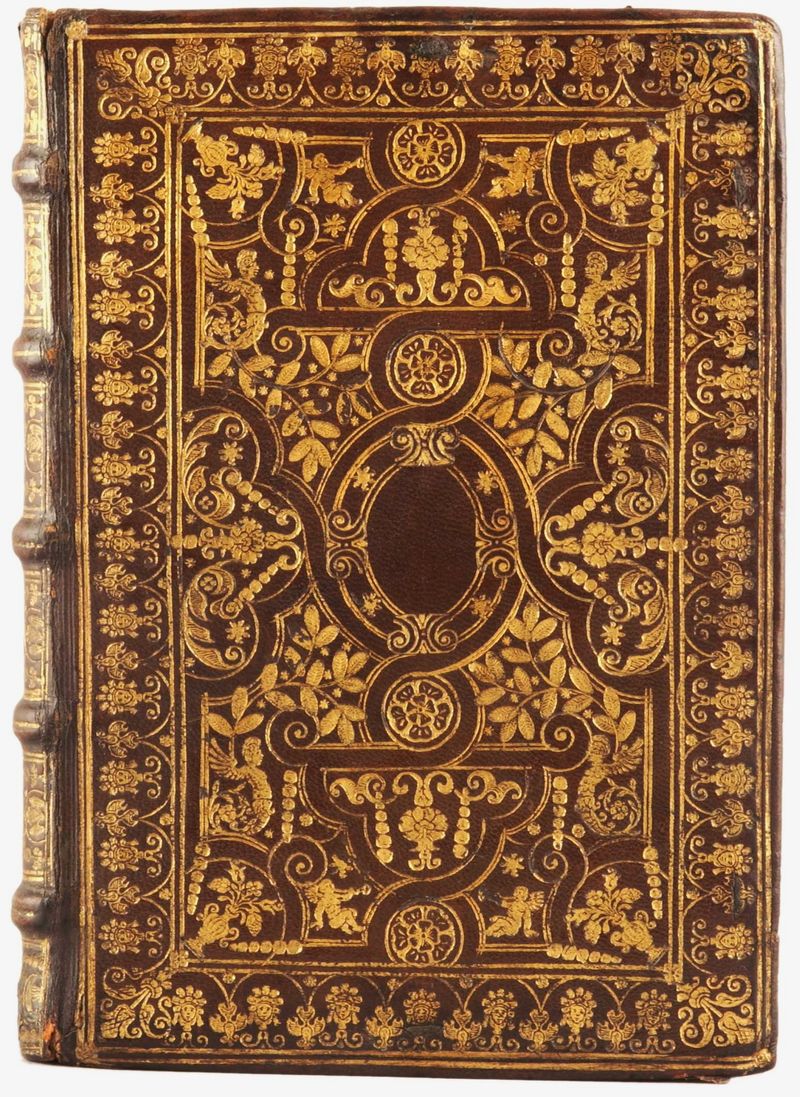 But then, these books are often remote and inaccessible. Those that aren’t held close to the chest in libraries can be prohibitively expensive. Even where easily acquired, these books need specialized knowledge, research and hard work, sometimes, to identify and even read. Communities of like-minded readers and collectors are hard to find, competitive, and sometimes hostile. People who do not share your mania will find discussions of books like these inaccessible and most likely boring. Professions specializing in books like these are scarce, hard to break into, and quickly becoming obsolete. Engaging with these books is lonely business.
But then, these books are often remote and inaccessible. Those that aren’t held close to the chest in libraries can be prohibitively expensive. Even where easily acquired, these books need specialized knowledge, research and hard work, sometimes, to identify and even read. Communities of like-minded readers and collectors are hard to find, competitive, and sometimes hostile. People who do not share your mania will find discussions of books like these inaccessible and most likely boring. Professions specializing in books like these are scarce, hard to break into, and quickly becoming obsolete. Engaging with these books is lonely business.
Anyone who thinks these two loves have anything at all in common is kidding themselves. People who love books and people who love books rarely overlap or have anything to say to each other. Yet, look. The Private Library featured this week a short introduction to Fanfare bindings. How could any warm body deny how beautiful these are? Or, meanwhile, even the driest academic or bibliographer gets excited once or twice a year when the latest Parker novel by Richard Stark is released, or in a year some massively deserving body like Hilary Mantel wins the Booker. I really wish there was much more overlap between these two worlds. I would love to see contemporary publishing publish less and take more care with the books they produce, drawing more from history and less from fashion when picking and producing their goods. Academic and antiquarian readers, meanwhile, have got to get with the program and make better use of social media and communities to spread and share knowledge about and enthusiasm for their object of interest.
I shouldn’t feel quite so two-headed when enthusing about one book or another. They are all books, right? Haven’t we got some more common ground?
December 13, 2010
We Edit While We Read
More than anything these days, I have been reading children’s books. I’ve been having trouble focusing on reading lately, but my 2-year-old has no mercy for me: for her, there’s still a 20-book-a-day requirement that needs to be met. We’ve both become pickier picture-book consumers lately, though our criteria don’t always match up. She gravitates towards the familiar – animals she knows, scenarios she recognizes – and me, I’m searching for the impossible.
I’m turned off by a lot in picture books. Some books are too saccharine, some are too preachy. Others have art that’s hard to make out, while others are too simple. When all else fails I reach for titles or stories I read as a child, relying on my child-self’s recommendation. But my child-self wasn’t very culturally aware, I guess, because now I’m just appalled by some of what I read.
I have been struggling with Rumpelstiltskin. We read a lot of fairy tales and yes, some versions are better than others, but I can’t make this one work. Everything about it offends me. A girl is given away as a gift by her braggart father to a greedy and cruel king. She’s put to work on pain of death. Rather than try to escape or solve her situation, she sits down and cries. Tears attract pity, and she’s helped by a hard-bargaining fairy. Eventually she marries her abuser and has a child by him. When her own stupidity comes back to bite her in the ass she, once again, cries her way out of it. Ultimately she comes up on the winning end of a riddle because her servant solves it for her.
 The first thing Maggie asked me when we started reading Rumpelstiltskin was “What’s the girl’s name?” Typically, she doesn’t have one in either edition we read (Marie-Louise Gay’s then, later, Paul Zelinsky’s.) She is known by her position: either the “miller’s daughter” or “the Queen”. I couldn’t stomach a heroine defined by her relationship to the abusive men in her life, so I immediately made one up for her – she is now Rebecca. Not a page later I was choking on the words again. The king – depicted in Zelinsky’s version as a handsome young man – is locking her in rooms and threatening her with little, if any, rebuke from the narrator. I couldn’t take this either. Every time the king comes up now I find myself adding “-who was a jerk-” to his name. I quickly flip past her wedding, where she is depicted looking bafflingly happy to be there.
The first thing Maggie asked me when we started reading Rumpelstiltskin was “What’s the girl’s name?” Typically, she doesn’t have one in either edition we read (Marie-Louise Gay’s then, later, Paul Zelinsky’s.) She is known by her position: either the “miller’s daughter” or “the Queen”. I couldn’t stomach a heroine defined by her relationship to the abusive men in her life, so I immediately made one up for her – she is now Rebecca. Not a page later I was choking on the words again. The king – depicted in Zelinsky’s version as a handsome young man – is locking her in rooms and threatening her with little, if any, rebuke from the narrator. I couldn’t take this either. Every time the king comes up now I find myself adding “-who was a jerk-” to his name. I quickly flip past her wedding, where she is depicted looking bafflingly happy to be there.
I grudgingly report the pathetic way in which she gives herself up for dead every other page but I had had quite enough by the end of the story. In my version, Rebecca doesn’t send her servant out to find Rumpelstiltskin’s name, she does it herself. Because she’s the heroine, right? She has to do SOMETHING in the book other than look pretty and pathetic. But in the end I feel I’ve cobbled together a still-sad tale that says some very dubious things about life to my very small daughter. I cringe when she requests the book.
Luckily, SurLaLune tells me that I am not the only one who finds this a troubling piece. Modern interpretations abound. I simply adored Susanna Clarke’s “On Lickerish Hill”, a telling of Tit Tat Tot, from her collection The Ladies of Grace Adieu, but it’s a bit beyond a 2-year-old, especially with the archaic language. But surely Maggie needs a grounding in the original story before she can appreciate, some day, these liberated versions? I just hope she doesn’t get any ideas from them. In the meantime I’m editing, shamefully, to keep hold of my sanity.
November 15, 2010
A Tour Around My Library
I’ve been tinkering with LibraryThing this morning because it strikes me as a tool made for people like me. Actually, I got an email almost exactly a year ago from Library Thing’s founder Tim Spalding offering to move heaven and earth to get me to use the service, so apparently I’m not the only one who thinks it’s the Tool For Me. After a couple hours of data entry and flailing, however, I am bewildered. I’m still not clear what I should be doing with it. I thought once I had all my books listed some kind of use or purpose might become clear, but when I ran into the 200-book limit of the free account I gave up and bailed.
Even the few books listed so far look wrong to me, like books I don’t own with only the most symbolic relevance to my actual shelves. I’m sure this is something that can be fixed with effort as I clean up ISBNs and covers, but there’s more to it than that. I think my “collection” might be too much of a mess to catalogue like this, or maybe just my collecting habits (which do, yes, run towards hoarding). Certainly my shelving and sorting regime is eccentric. It isn’t messy (well, okay, it is) or disorganized, in fact I’ve got every last book shelves exactly where I want it. Sub-collections, groupings and pairings mean a lot to me. But there’s a gradient, a volatility, a flexibility I enjoy that makes labeling difficult. I moved three months ago from a place I’d lived in for five solid years to a bigger, much more book-friendly space. To this day I have not unpacked several boxes of books because I can’t decide where to put them. Until exactly the right placing presents itself, I’d sooner keep them in boxes.
But enough of the words. If the internet has taught us nothing else, it has revealed that bookshelves are better seen than described. Mine aren’t works of art (I’m aesthetically and artistically barren), but I feel they explain my collection better than LibraryThing can.
This is a typical Charlotte’s Book Shelf. A disaster, yes. But look closer.
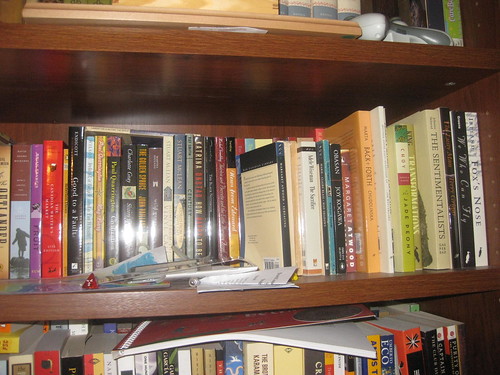
Canadian Literature, Trade Paperback (Partial)
In fact, the shelf houses several sub-collections. The top is Old Valuable Books of No Particular Subject (including a 6-volume Oxford Illustrated Jane Austen and a 1st edition Once and Future King by T.H. White in dust jacket). Next, pictured here (left), is Canadian Literature, Trade Paperbacks – which is to say, minus hardcovers and mass market editions (which are grouped elsewhere). Below that we have Contemporary Literature, Trade Paperbacks stacked in front of (and quite obscuring) Literary Non-Fiction, Paperbacks (below). Are you still with me? Good.
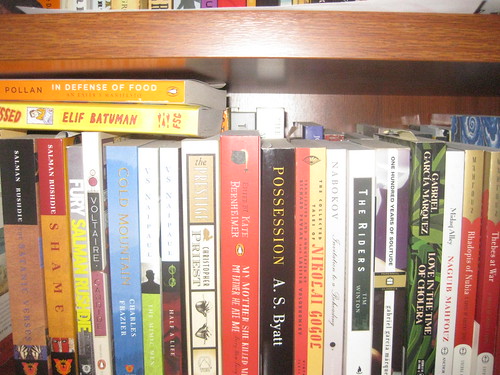
Contemporary Literature, Trade Paperback, Partial
Further ’round the room things got more complicated. I have one entire bookcase devoted to hardcovers, and I’m still not clear exactly how to order them, so I went with the unusual tactic of shelving by preference. That is, my Favourite Hardcover Novels are on top, followed by my Favourite Hardcover Non-Fiction Titles (including my becoming-unwieldy sub-collection of Robertson Davies reference works). Below that we have Assorted Books On Magic Which Are Too Big To Shelve Alsewhere (including Plato’s Complete Works and a Shorter Oxford English Dictionary – not strictly books on the occult, but if you think creatively enough it fits), and taller pieces of my husband’s Tolkien collection, which continues on the next shelf.
A note on my husband’s books: he doesn’t have many. When we started dating I made it clear I was a book collector, but I don’t think he realized he the gravity of the situation until we moved in together and he found he was moving into a library. Whatever impulses he might have had to buy books were quickly and firmly quashed by pragmatism. Who needs to buy books when you live in a library? It would be cheaper this way. To his credit, he has not (yet) become a spouse who demands the collection be culled. Much.
My collection of Alexandre Dumas is actually much less well-ordered than you’d think. It had the misfortune of being unloaded next to the computer, and next-to-the-computer detritus inevitably joined my little Musketeers and Cardinal’s Men up there.
The Young Adult Literature, on the other hand, came together just fine. Of course, half of it seems to be missing. What does this say about my friends and family that this is what is most frequently borrowed from my shelves?
I am a big one for “prioritizing” my books. Not, like a smart lady, in terms of “read” and “unread”, but in terms of “to be shown off” and “to be hidden”. I acquire quite a lot of free books in the form of damaged discards, promos and garage sale finds which I take without discrimination, reasoning that I might need them some day, or you never know when something will come in handy. On the other hand, I don’t really want to display copies of, say, Atlas Shrugged, beat up old editions of Augustine and Defoe, Environmental Studies textbooks, or somewhat dogmatic analyses of current events like It’s the Crude, Dude or God Is Not Great. These go on bottom shelves, or are hidden in my bedroom.
But, find an empty bookshelf and find some books to fill it – if my house were a bookstore, we’d also call this “overstock”. So much of this stuff is books I just don’t know what to do with. In a fit of frustration, I started shelving these by publisher. I also discovered, to my dismay, that I have no fewer than three full shelves of back-issues of magazines – old Walruses and National Geographics mainly – things which shelve poorly and were relegated to the Shelves of Shame for their lack of spine. Sadly, this is also where my old, beat-up mass market Canadian books are. Not that they are objects of shame, but mass market editions fit poorly onto Billy bookshelves, which offer so much vertical space that they’re best filled with the taller trade paperbacks and hardcovers.
Ah, the office. Moving into the new house we harboured a fantasy that we’d have time to lock ourselves away and work on our respective intellectual pursuits. Ha! Maybe in another two years, when the 2-year-old doesn’t regard a closed door as a mortal offense. Still, I like to think my Book History collection and my husband’s Philosophy books look nice all together.
Now don’t be misled by all the empty space. I’ve boxes and boxes of books left to unpack – but I’m paralyzed with indecision right now. I don’t know where to put my piles of mass market fantasy books – they can’t very well be shelved next to Philosophy or in the the Nabokov. And surely there’s a better use of my office shelves than unloading the remaining damaged and garage-saled miscellany into it? And I tell you I don’t know where I’m going to put this 3-Volume Autobiography of Mark Twain when I get it home – it needs a shelf unto itself.
Anyway, it’s not all a giant mess. I have at least one nice, reasonably well-organized shelf. I’d better not add anything to the collection though, I’m plum out of space.
I’ve been working on a collection on The Intellectual Roots of Speculative Fiction, and this is much of it. Myths, legends, epics, retellings and early fantasies – these go here. As more arrive the contemporary genre titles get shuffled away (into oblivion – they don’t have a home yet). That’s the way of my sorting. Placeholders, like-titles, reclassified as space requires. There’s no hard-and-fast rules. I keep Crowley’s Little, Big with this History of Fantasy stuff, along side Lord Dunsany and The Worm Ouroboros. But Nalo Hopkinson and Charles de Lint will have to move on eventually – exactly why I couldn’t tell you, but they don’t belong, just yet.
I tired to denote this with overlapping categories on Library Thing, but every time I moved a book I felt pressure to change all the categories. With several thousand titles, I think this could start to become ridiculous. So I’m out, Library Thing. I tried. I’m either too organized or not organized enough for you! But thank you, and I will enjoy browsing other peoples’ libraries for the time being.
Oh, and if you’re curious – you can view my minimal Library Thing profile here. Maybe you can spot what I’m doing wrong? Meanwhile, I hope you enjoyed my more meandering tour!
November 12, 2010
Book: The Art you can Take Home
I hope you will all excuse me a personal, someone saccharine post. It does run bookish, eventually. I’ve had a rough couple of months, in truth. Those of you with children will understand: kids at the younger end of the spectrum sometimes go through phases (weeks, months, years) that force a mother to suspend her own well-being for a while. Sleep and peace of mind are the two biggest casualties, though don’t consider this a complaint. They are freely sacrificed. I might be incoherent and incapable of following an idea through to its logical conclusion, but that’s small potatoes in the wide world of well-being, mental health and safety.
My daughter, Miss Margaret, has been attending daycare full-time since the beginning of September. She was barely 2 years old when she began, and she’s 28 months old now. Like it is for so many little kids, the transition was rough. Though she enjoyed her first week, once she recognized this was to be a regular thing the resistance began. The Screaming Meltdowns began, the tears and the clinging and the begging for “one more hug, just one more hug!” at drop off. We were told to expect a couple of weeks of this.
After 6 weeks of this we wondered if something was up – not only did the Screaming Meltdowns show no sign of abating, but daycare has become a taboo subject around our house. “No! No! Nuffin’!” She yells at me when I ask her how her day was. “Nuffin’ about daycare!” She refuses, at daycare, to take any of her outdoor clothes off, or put any of her belongings away. She needs them, she says, for when Mama comes back. I find out how her day was through play. I might catch her sending one of her dolls “to the baby room” when the doll yells too much. She has elaborate conversations on her fake cellphone about which kids bit her and which kids hit her. Once or twice, just before drifting off to sleep at night, she has whispered something to me like “Mama, my friends at daycare not have words.” She has never said a positive thing about the place, ever.
It has been suggested that the problem is me, that I have a “negative attitude” towards the place and Maggie “picks up” on my vibes. I disguise my opinions on the matter as best as I can, hype the place up and approach it smiling each day, but meanwhile she has become more devious in avoiding it. “Okay, Mama.” she said, resigned, one day. “I come to work with you. I work at Bob Miller.” Nice try kid. This morning: “Mama, when I start school? I go big kids room today?” “It’s the weekend!” she announced, smiling, on Wednesday. Over the last four months she has lost much of the independence we’d gained up to that point. She will no longer sleep by herself. She wakes up screaming things like “No! Not take my hat off! I want my mom!” She started wetting the bed.
Well, you know, these are some toxic vibes I give off. In any case, Maggie spends 9 hours a day, 5 days a week in daycare, so I do my best on weekends to make up for it. Two full, luxurious days of family time. One of the issues with the daycare seems to be that Maggie isn’t a baby anymore, unlike many of the other kids. They don’t talk yet (much); Maggie does nothing but talk. They have a brief story-time, but the books are single-sentence board-books, compared to the long form picture books (Curious George Flies a Kite and Library Lion are this week’s faves) and short chapter books (Burgess’s Adventures of Jimmy Skunk and Winnie the Pooh are happily preferred) we read at home. They don’t do many structured activities, though “art” like gluing feathers to paper plates finds its way into her cubby-hole at the end of each day. She wants interactive, stimulating, challenging activities with the non-hitting, non-biting, non-grabbing safety of her mom.
I want to bring her to the museum and the art gallery, to puppet shows and plays. I want to bring her to concerts and demonstrations and readings. I want to expose her every day to the wealth and variety of cultural life available here in Toronto. But time is so short, and so rushed. Two days. Two days minus naps, the urgent, oft-neglected housekeeping and family obligations. In the end we’re lucky if we can manage one activity a weekend, and often it feels forced and cut short. It takes her a full day to “unwind” from the stress of the week and to really relax enough to enjoy herself. Art, and cultural education, is supposed to be a foundation of a good liberal, Humanistic society. Maggie is younger then one might usually worry about introducing those things to a kid, but she’s clearly ready and enjoys it when rarely we fit it into our lives. Do I hope these values will be instilled by the institutions I’ve already committed her to? Will there be a natural bridge from the campy CDs played in the background at daycare to the knowledge of what a violin is, and a desire to play one? Will they take her to the theatre? Will they teach her to dance?
At the end of every day Maggie starts pulling books off the shelf and piling them next to me. I always swore I’d read to her as much as she liked, until I realized she’d listen for hours each day if I had the voice for it. Now we bargain, like Olivia and her mother from Ian Falconer’s eponymous books. Five books, maybe six. Okay, one more. We are heavy library users, withdrawing ten new books every three weeks like clockwork. The library is a fixture of our lives. This, at least, I can do: the books are there, and need no tickets, travel or preparation to enjoy. For Maggie the appeal of the book is as much the chance to reconnect with mommy and daddy through the hours spent curled up on our laps, warm and comforted, as it is the story. However miserable our days have been, everything stops when we settle in to read. Her anxiety and crankiness melts away, as does mine. We read, talk the book over, bargain over what to read next, move on.
I don’t know if this makes up for what we’re missing out on. I envy stay-at-home moms violently. But it is what I have to offer. The realities of our life have whittled the ideal down to this: there is a huge, varied, diverse world of ideas and sensations out there, and we can glimpse it through books. Whatever else we can’t find time for, there is always time for reading, and for that I am very, deeply grateful. To all the other things I love about books, you can add this to the top of the list in big, boldface type. They are the very best gift I can give my daughter.
June 30, 2010
Too Busy to Blog
“Every passion borders on the chaotic, but the collector’s passion borders on the chaos of memories. More than that: the chance, the fate, that suffuse the past before my eyes are conspicuously present in the accustomed confusion of these books. For what else is this collection but a disorder to which habit has accommodated itself to such an extent that it can appear as order?”
Walter Benjamin, Unpacking my Library: A Talk about Book Collecting (1931)
June 16, 2010
Reader’s Guilt
I’m having a miserable week of sleep deprivation, sick and cranky toddlers and moving stress which, naturally, puts me in no frame of mind for either sending or receiving coherent textual information. Proper blog posts, papers and articles sit in draft form on three computers. I try to make headway with Byatt.
I consider myself a fairly disciplined reader. I force on myself a reading schedule under which I am prevented from reading “too much” of any one genre – I try to balance old with new books, fiction with non-fiction, Canadian with International. I try, generally, to stick to one book at a time, to avoid philandering. I do my best to finish books no matter how dull and uninteresting I find them.
This doesn’t always work. I’ve had to abandon books from time to time. I was comforted to learn recently that I’m not the only one who couldn’t stomach Ishiguro’s The Unconsoled. I gave up on Richard Fortey’s geological epic The Earth. More recently I tossed William Buck’s edition of The Mahabharata (it was not at all as inspiring and engaging as Ramesh Menon’s Ramayana, one of my all-time-favourite reads). And, embarrassingly, I didn’t finish Afua Cooper’s The Hanging of Angelique.
But that isn’t bad, I think. It’s a few books from many. I’m generally, as I say, disciplined.
Nevertheless I have to make a confession about which I feel even worse than I do for failing to finish certain dull books:
I can’t read the poetry in A.S. Byatt’s Possession.
Alright, a snippet here and a couplet there, yes. This is fine. But the 8-page rendition of Swammerdam? Entire chapters of Ragnarok? I can’t do it. I want to just flip, flip, flip, until I return to the narrative. And I can’t shake the feeling that this makes me a deeply flawed human being (tongue only slightly in cheek). After all, this is a story about poets, about poetry, about the meeting of souls through text. And I’m skimming for plot. But I can’t help it. I’m just deeply uninterested in the poetry. In that sense (and watch for fuller elaboration when I review the book) I am absolutely the opposite sort of reader than the book’s two scholars – I care not a whit for the text, but quite a lot for the biographical details of the lives of the poets.
I am absolutely in love with this book, despite my vulgar reading of it. But who knows how much less I’m getting out of it than I could? Fret, fret. I get so much reader’s guilt! Anyone who thinks reading is a form of entertainment and not some more complex process of self-vetting is kidding themselves. None of us come out of this process pearly-white.
